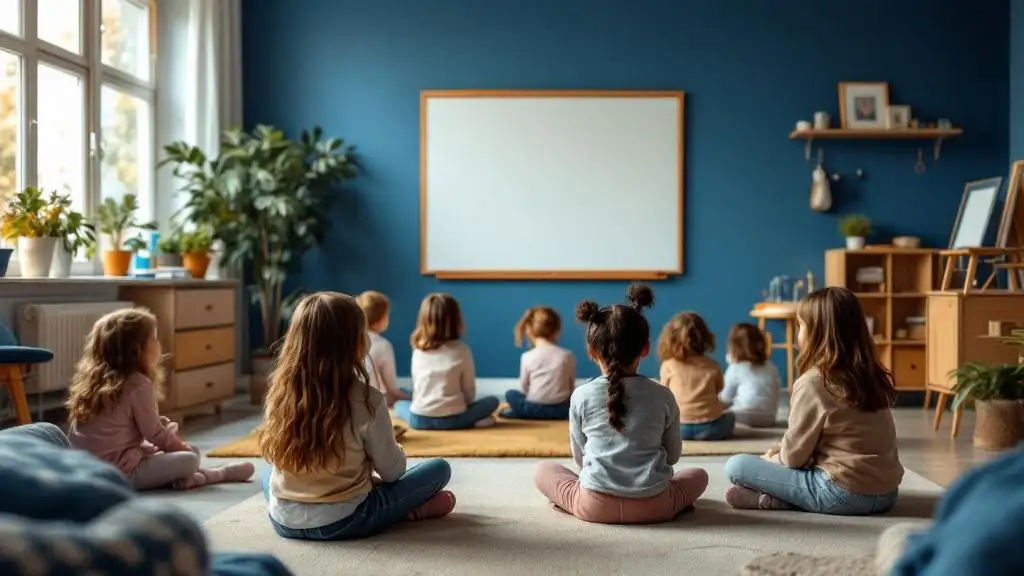
Understanding Receptive Language and Its Significance
Receptive language is fundamental to effective communication and learning. It encompasses a child's ability to understand spoken words, instructions, and nonverbal cues, forming the foundation for meaningful interactions and educational success. Recognizing its importance early can significantly influence a child's social and academic development.
What Is Receptive Language and Its Developmental Milestones

What is receptive language and why is its development important?
Receptive language refers to a child's ability to understand and interpret spoken, written, and nonverbal messages. It involves gaining meaning from words, gestures, sounds, and symbols, which is fundamental for effective communication. When children develop strong receptive language skills, they can follow directions, comprehend stories, interpret questions, and understand social cues more easily.
This understanding is vital because it forms the base for learning and social interaction. Children who struggle with receptive language might have trouble paying attention, following instructions, or understanding conversations, which can affect their behavior, academic progress, and social skills. Developing these skills supports overall literacy, emotional regulation, and independence.
Milestones in receptive language progress
Receptive language skills develop gradually from infancy through early childhood. In the early months, babies respond to sounds and recognize their name. By around the age of one, children start understanding simple words and routines.
As they grow, their ability to comprehend more complex instructions and concepts improves. By age two or three, children can follow multi-step directions and understand basic questions.
Between ages four and seven, receptive language expands to include understanding stories, figurative language, and abstract concepts. They can comprehend vocabulary at more advanced levels and interpret emotional cues and social nuances.
Supporting this development involves activities like reading picture books, engaging in conversations, using visual aids, playing listening games, and maintaining structured routines. These methods help children advance from understanding simple commands to grasping complex ideas, laying the groundwork for academic success and social competence.
Understanding Receptive Language Disorders andSymptoms

Characteristics of receptive language difficulties
Receptive language difficulties involve challenges in understanding spoken language, including words, sentences, and context. Children with these issues often struggle to follow directions, interpret stories, or grasp concepts conveyed through speech. These difficulties are not typically due to hearing impairments or intelligence deficits but stem from underlying processing issues in understanding language.
Receptive language skills encompass understanding vocabulary, identifying relationships between words, and interpreting information conveyed through gestures, visuals, or written text. When these skills are delayed or impaired, children may find it hard to participate effectively in classroom activities, social interactions, and daily routines.
Common signs and symptoms
Signs pointing to receptive language problems include trouble following multi-step instructions, not responding appropriately in conversations, frequent repetitions of questions, and difficulty comprehending stories or instructions. Children might appear distracted, need multiple prompts, and often look to others to understand what is being said.
Other indicators include difficulty answering questions about content they’ve heard, struggling with understanding figurative language, and missing parts of conversations or instructions. Such children may also demonstrate inconsistent comprehension, especially in noisy environments or group settings.
Impact on everyday functioning
Receptive language delays can influence many aspects of a child's life. Challenges in understanding instructions can hinder academic progress and increase frustration. Social interactions may suffer, as children struggle to interpret social cues or participate meaningfully in play.
Behavioral issues can arise because of misunderstandings or inability to express confusion appropriately. Literacy development may also be delayed, affecting reading comprehension and overall academic achievement. Early intervention through speech therapy can significantly improve these skills, enhancing overall participation and confidence.
| Aspect | Receptive Language Features | Effects of Difficulties | Supporting Strategies | |-------------------------------|---------------------------------------------------------------------|----------------------------------------|--------------------------------------------------| | Understanding instructions | Following multi-step commands, responding to questions | Academic delays, frustration | Visual aids, simplified instructions, modeling | | Story comprehension | Answering questions about stories, understanding main ideas| | Social skills | Interpreting social cues, understanding humor or figurative language | Social withdrawal, behavioral issues | Play activities, social stories, visuals | | Daily routines | Recognizing schedules, following routines | Dependence on adults, safety risks | Routine charts, visual schedules |
How are receptive language disorders diagnosed, and what are common symptoms?
Receptive language disorders are diagnosed through comprehensive evaluations conducted by speech-language pathologists, which include standardized tests, informal assessments, and screenings for hearing and vision problems. These assessments evaluate an individual's understanding of vocabulary, following directions, answering questions, and comprehension of conversations across all spoken languages used.
Diagnosis involves identifying difficulties in understanding age-appropriate language, instructions, and social cues, while ruling out other conditions like autism or intellectual disabilities. Observation of behavior in various settings and understanding developmental norms aid in distinguishing typical delays from receptive language disorder.
Once diagnosed, targeted speech therapy and supportive strategies are recommended to improve comprehension and communication skills.
Speech Therapy: A Tailored Approach to Enhancing Receptive Language Skills
Assessment procedures in speech therapy
Before starting any intervention, speech-language pathologists (SLPs) conduct comprehensive assessments to identify a child's specific receptive language difficulties. These assessments include language comprehension tests that measure understanding of vocabulary, following multi-step directions, and making inferences. Additionally, SLPs may perform games, observational evaluations, hearing and vision tests, and psychological assessments to gain a detailed picture of the child's language abilities.
The results help pinpoint areas where the child struggles, such as understanding story details or grasping certain concepts. This thorough evaluation ensures that therapy can be precisely tailored to target the child's unique needs.
Personalized treatment planning
Based on assessment outcomes, therapists develop individual therapy programs focused on strengthening the child's receptive language skills. Plans often include activities that improve vocabulary, listening comprehension, and the ability to follow instructions.
Therapeutic strategies are adjusted to match the child's age, developmental level, and specific challenges. Visual supports, like pictures, symbols, and graphic organizers, are frequently integrated to enhance understanding. In some cases, multidisciplinary approaches involving occupational therapists or psychologists are recommended, especially if receptive language difficulties are part of a broader developmental concern.
Goals of therapy
The primary aim of speech therapy for receptive language is to help children better understand spoken language, which is crucial for learning and social interaction. Goals typically include enabling the child to follow multi-step directions, comprehend story content, interpret questions accurately, and learn new vocabulary.
Therapists also focus on improving inferential skills, such as understanding implied meanings and recognizing relationships between concepts. Ultimately, the objective is to foster independence in everyday communication, support academic success, and enhance social participation.
| Therapy Components | Focus Areas | Methods Used |
|---|---|---|
| Assessment procedures | Identifying specific comprehension difficulties | Language tests, observations, hearing evaluations |
| Treatment planning | Individualized strategies to target weaknesses | Visual aids, simplified instructions, modeling |
| Therapy goals | Improving following instructions and understanding | vocabulary expansion, story comprehension, question answering |
How can speech therapy help improve receptive language skills?
Speech therapy provides a structured, personalized approach to help children overcome receptive language challenges. By diagnosing specific areas of difficulty, therapists employ various techniques—such as visual supports, simplified language, and engaging activities—to boost understanding. Repetitive practice with key concepts, modeling, and play-based exercises encourage children to grasp and retain new information.
Moreover, therapy emphasizes building listening skills, attention, and the ability to infer meaning from context—all vital for understanding stories and instructions. Engaging caregivers in home activities further supports progress. Overall, speech therapy equips children with the tools to understand language more effectively, supporting their success in school, social settings, and daily routines.
Proven Methods and Activities in Speech Therapy for Receptive Language
Reading activities and picture pointing
Engaging children with picture books is an effective way to develop receptive language skills. Caregivers and therapists can encourage children to find and point to pictures while reading, which promotes understanding and vocabulary expansion. Asking questions about story content and prompting children to label objects helps reinforce concepts and supports comprehension.
Following directions games
Games like "Simon Says" are excellent for practicing the ability to follow spoken instructions. Starting with simple commands and gradually increasing complexity helps children improve their attention and processing of multi-step directions. Additionally, activities such as grocery shopping simulations or Simon Says variations can make learning interactive and fun.
Use of visual aids and categorization exercises
Visual supports, including pictures, symbols, and graphic organizers, simplify language processing. Categorization tasks, where children sort objects or pictures into groups (like animals, foods, or colors), enhance understanding of concepts and relationships between items. These tools make abstract language more concrete, aiding children in grasping new vocabulary and instructions.
Narrative storytelling and role-playing
Storytelling activities encourage children to process language in context. When children retell stories or participate in role-playing, they practice understanding sequences, vocabulary, and social cues. Using props and role-play scenarios helps children link words to actions and situations, strengthening both receptive and expressive language skills.
Support and intervention approaches for children with receptive language delays
Support and intervention approaches for children with receptive language delays include speech therapy, which assesses and targets specific comprehension difficulties through individualized or group sessions. Incorporating structured activities such as reading, role-playing, and games helps enhance understanding of vocabulary, concepts, and language cues. Using visual supports like pictures, symbols, and concrete objects can aid children in processing spoken language and maintaining attention. Behavioral strategies, such as providing simplified language, offering choices, and developing picture or word schedules, help foster understanding and routine. Early intervention, caregiver training in language facilitation strategies, and environmental modifications are also crucial for improving receptive language skills and functional communication.
Diagnostic and Assessment Strategies for Receptive Language Difficulties
Receptive language difficulties can significantly impact a child's ability to understand spoken words, follow directions, and engage fully in learning and social interactions. Identifying these challenges requires careful assessment by trained professionals, typically speech-language pathologists.
One of the primary tools used is language comprehension tests. These standardized assessments measure a child's understanding of vocabulary, ability to follow multi-step directions, answer questions about stories or conversations, and infer meaning from context. The results help pinpoint specific areas where comprehension may be delayed or impaired.
In addition to language testing, it’s important to screen for hearing and visual issues. Since hearing and sight problems can mimic or contribute to receptive language difficulties, audiologists and ophthalmologists often collaborate to rule out these factors. Normal hearing and vision are crucial for effective language understanding, so their assessment is a vital part of the diagnostic process.
Observation also plays a key role. Therapists and clinicians monitor developmental and behavioral behaviors in different settings, such as home, school, or therapy sessions. They look for signs like difficulty attending to spoken language, inconsistent responses, or a lack of understanding of everyday instructions.
A comprehensive evaluation typically combines these assessments: language comprehension tests, hearing and visual screenings, and behavioral observations. This multifaceted approach helps professionals differentiate between typical developmental delays and actual receptive language disorders.
Once a diagnosis is made, tailored intervention plans involving speech therapy are implemented to improve understanding skills. These programs often include activities to enhance vocabulary, improve listening skills, and build comprehension through visual aids and contextual learning.
What are common symptoms of receptive language disorders?
- Difficulty following instructions
- Challenges understanding stories or conversations
- Not responding appropriately to questions
- Struggling to grasp new vocabulary
- Missing details in instructions or stories
Early diagnosis and appropriate intervention are essential for helping children develop better communication skills, boosting their confidence and participation in daily activities.
Supporting Receptive Language Development at Home: Tips for Parents and Caregivers

What tips can parents and caregivers follow to support receptive language development at home?
Parents and caregivers play a vital role in nurturing receptive language skills by creating an engaging and language-rich environment. One effective method is integrating reading into daily routines. Reading picture books, describing the illustrations, and asking questions about the story help children build vocabulary and comprehension. For example, pointing out objects, naming them, and encouraging children to do the same supports understanding.
Incorporating fun language games can also boost receptive skills. Games like 'I Spy' involve identifying objects based on descriptive clues, promoting vocabulary and concept recognition. 'Simon Says' is excellent for practicing following directions, especially when instructions increase in complexity gradually. The game 'Twister' can teach children about body parts, directions, and spatial concepts through physical activity.
Using simple instructions and visual supports is crucial. Break tasks into clear, manageable steps and confirm understanding by asking children to repeat or show what they've understood. Visual aids such as pictures, symbols, or real objects can reinforce what’s been said, making abstract language more concrete.
Encouraging questions and active listening creates opportunities for children to process language deeply. Prompt children to ask questions about their environment or stories, and respond with patience and enthusiasm. When children do ask questions, modeling full responses and providing explanations helps them learn how to process and respond effectively.
Creating opportunities for practice in everyday settings, such as grocery shopping, mealtime, or playing, allows children to apply their receptive language skills in real-life contexts. Repetition and routine help children predict and understand language better, reducing frustration and fostering confidence.
Overall, consistent interaction, clear communication, visual supports, and playful activities support children’s natural language development. Early engagement and positive reinforcement are essential, particularly for children showing signs of receptive language delays. These strategies not only help improve understanding but also set the stage for expressive language and social skills growth.
For further advice, searching for "Parent strategies for supporting receptive language at home" can provide additional tailored activities and expert guidance.
Empowering Children Through Effective Speech Therapy Strategies
Supporting receptive language development through speech therapy and home-based activities is vital for children's success in communication, learning, and social integration. Early intervention, tailored approaches, and caregiver involvement significantly enhance a child's ability to understand spoken language, paving the way for improved expressive skills and overall development. With consistent, strategic efforts and professional guidance, children with receptive language difficulties can achieve meaningful progress and thrive in their daily interactions.
References
- Expressive vs. Receptive Language - TherapyWorks
- Receptive Language (understanding words and language)
- How Speech Therapy Can Help Develop Receptive Language
- Teaching Receptive Language Skills: Recommendations for ...
- Treatments for Receptive Language Disorders in Children
- 10 Tips to Improve Receptive Language for Children with Autism
- Supporting Your Child's Receptive Language Skills - Learning Links
- 7 Activities to Improve Receptive Language
- Receptive Language Disorder | Speech and Health Library












